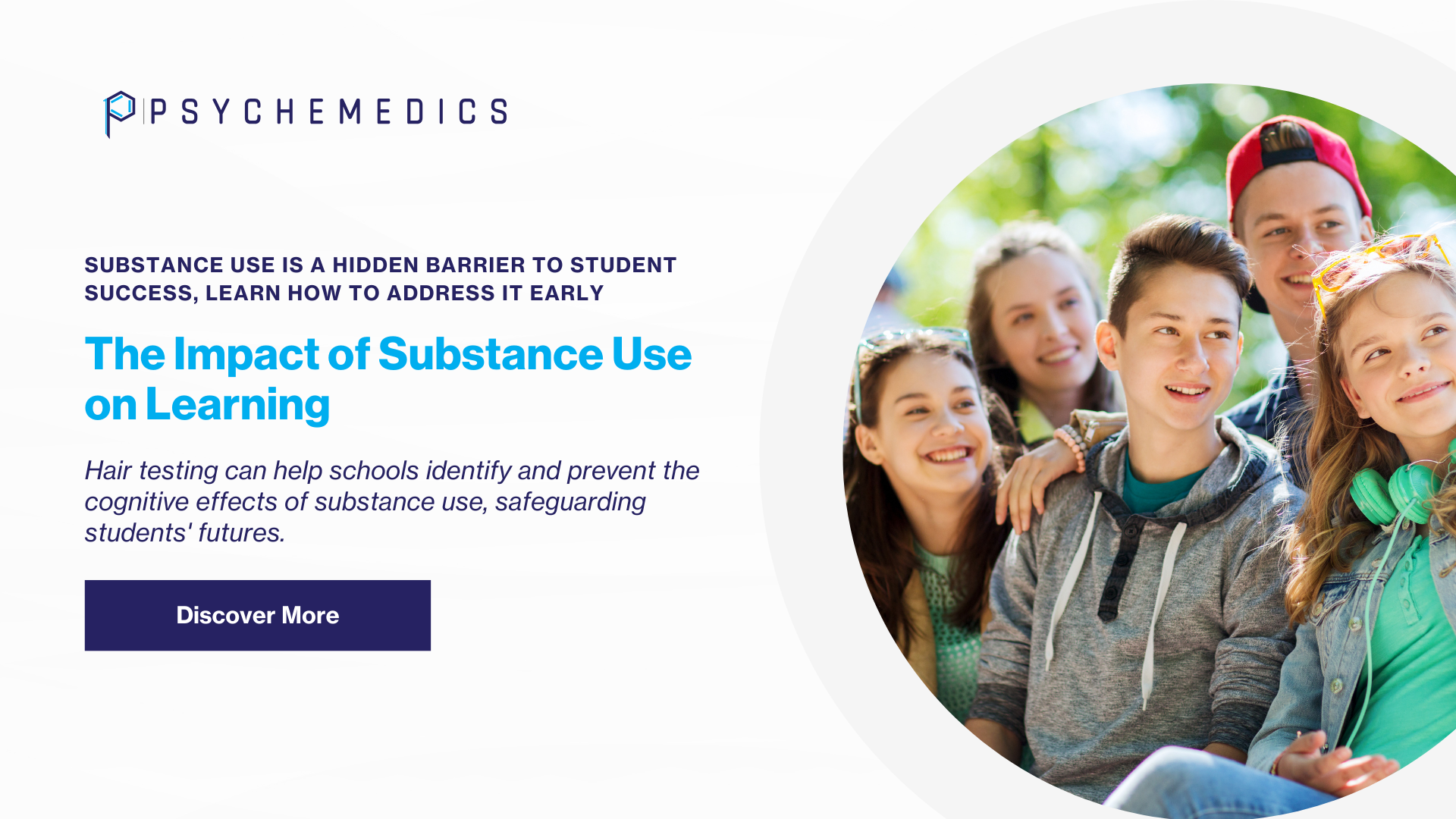Student success doesn’t begin and end with grades. It’s shaped by focus, mental health, emotional regulation, and the ability to thrive in a supportive school environment. But when substance use enters the equation, whether it’s recreational, experimental, or peer-influenced, even the most capable students can lose their footing.
Educators, counselors, and parents may sense something is off. But identifying the root cause, especially early on, is often difficult. This is where advanced drug testing, especially hair testing, plays a pivotal role in helping schools take proactive steps to safeguard students’ futures.
Academic Disruption: The Cognitive Cost of Drug Use
Substance use doesn’t just compromise health; it actively interferes with a student’s ability to learn, process, and retain information. As substances become more potent and accessible, the academic consequences become harder to ignore.
Drugs like marijuana, prescription stimulants, benzodiazepines, and even fentanyl-laced counterfeit pills can impair:
- Short-term and working memory
- Focus, attention, and concentration
- Executive functioning (planning, organizing, prioritizing tasks)
- Motivation, attendance, and engagement
- Sleep quality, which directly affects cognitive performance
As these effects accumulate, students may fall behind or disengage entirely. Missing assignments, plummeting test scores, and a noticeable decline in class participation often follow. Still, these symptoms can be mistaken for typical adolescent behavior or stress if the root cause isn’t identified.
Behavioral Shifts: Warning Signs That Are Often Overlooked
While academic decline is often the most visible consequence, drug use also triggers behavioral changes that can disrupt not just individual learning, but the overall classroom environment. Teachers, coaches, and school counselors are usually the first to observe these red flags, but without tangible evidence, intervention may be delayed.
Common behavioral signs of student drug use include:
- Sudden mood swings, irritability, or aggression
- Withdrawal from social circles or a new peer group
- Apathy or lack of interest in once-enjoyed activities
- Defiance of rules, disrespect toward staff, or classroom disruptions
- Changes in personal hygiene or physical appearance
- Increased absenteeism or tardiness
When left unaddressed, these behaviors can spiral into disciplinary issues, alienation, and deeper mental health struggles. Early recognition and support are critical, and data-driven testing provides the clarity needed to act.
The Hair Testing Advantage: Long-Term Insight for Meaningful Intervention
Not all drug tests are created equal. Traditional methods like urine or oral fluid only capture recent use, typically within the last 24 to 72 hours. These short windows may completely miss patterns of intermittent or recreational use, especially when students are aware of test schedules and know how to prepare for them.
Hair testing changes the equation. With a 90-day detection window, Psychemedics’ hair testing technology offers unmatched visibility into long-term patterns of substance use, making it an ideal solution for school settings where early identification and prevention matter most.
Why More Schools Are Turning to Hair Testing:
- Extended detection window to identify patterns, not just isolated incidents
- Non-invasive, observed collection reduces privacy concerns and tampering risks
- Proven lab accuracy with a comprehensive panel that includes emerging drugs like fentanyl
- Supports a prevention-first approach, focused on early intervention and support
- Promotes parental partnership by opening up honest, constructive conversations
By identifying use earlier and more accurately, schools can intervene with counseling, support programs, and health resources—before a student’s future is derailed.
Creating a Culture of Safety and Support
Some may view drug testing in schools as a disciplinary tool, but when implemented thoughtfully, it becomes a cornerstone of student wellness and prevention. Hair testing, in particular, helps shift the narrative from suspicion to support, sending a clear message to students and families:
We care. We’re paying attention. And we’re committed to your success.
More than just policy, it’s about creating a culture where students know that help is available, trust is nurtured, and safety is prioritized.
Taking Action: What School Leaders Can Do Today
Educational institutions don’t have to wait for a crisis to act. There are clear, proactive steps schools can take to protect students and foster a healthier learning environment:
- Educate faculty and staff on recognizing early signs of drug use
- Implement a drug prevention policy that emphasizes intervention over punishment
- Consider hair testing as part of a broader wellness and safety initiative
- Involve parents in the process to create a strong school-home partnership
- Utilize test results as a tool for referral to counseling, mentorship, or recovery programs
Taking these steps shows a commitment not just to academic excellence, but to the overall well-being of every student on campus.
Every Student Deserves a Clear Path Forward
Drug use among teens isn’t just a personal issue; it’s an educational one. From slipping grades to disruptive behaviors, the impact reaches far beyond the individual student. But with advanced tools like hair testing, schools can gain the insight they need to intervene earlier, support more effectively, and protect the integrity of the learning environment. When schools lead with prevention, partnership, and purpose, students are empowered to rise above risk and stay on track for success.
References:
- King, Kevin. “SUBSTANCE USE and ACADEMIC OUTCOMES: SYNTHESIZING FINDINGS and FUTURE DIRECTIONS.” Addiction, vol. 101, no. 12, Dec. 2006, pp. 1688–1689, https://doi.org/10.1111/j.1360-0443.2006.01695.x.
- Just Think Twice. “How Does Drug Use Affect Your High School Grades? | Just Think Twice.” gov, 2011, www.justthinktwice.gov/how-does-drug-use-affect-your-high-school-grades.
- Office of Juvenile Justice and Delinquency Prevention. “Consequences of Youth Substance Abuse.” ojp.gov, Office of Juvenile Justice and Delinquency Prevention, May 1998, ojjdp.ojp.gov/sites/g/files/xyckuh176/files/pubs/drugid/ration-03.html.
- —. “The Link between Teen Substance Abuse and Academic Performance.” The Berman Center, 15 Oct. 2024, bermancenteratl.com/teen-substance-abuse-and-academic-performance/.
- Poliakoff, Michael. “Data Show Alcohol and Drug Use Hinder Academic Performance | Campus Drug Prevention.” campusdrugprevention.gov, www.campusdrugprevention.gov/views-from-the-field/data-show-alcohol-and-drug-use-hinder-academic-performance.

